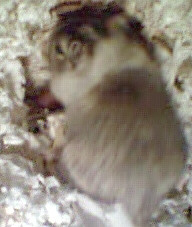
Whether you got an accidental litter of pups from two 'same sex' gerbils from the pet store, or you are planning on getting into the world of gerbil breeding, there are some things you need to know. I have been breeding gerbils for over 6 years, and I have learned some things about it that I will share with you.
(I am just starting this - I will work on it more later. Please check back again.) Gerbil Breeding Basic Info Gerbil pairs will have babies about once a month. It is very common for the female to get pregnant immediately after giving birth. If you are looking to just have a couple litters, you can put the male and female
together, then when they have their litter they will most likely mate again and the female will be
pregnant with the 2nd litter. When the 1st litter is fully weaned and old enough to be removed
from mom and dad, take dad out as well. Leave only one of the daughters in with mom to help
care for the next litter when it arrives. Keep a son with dad, so he will have company, too.Then, when that 2nd litter is ready to go, and they find their new homes, mom
will have a daughter to live with, and dad will have a son, so no one will be lonely.Also, you'll need a permanent set-up for the dad and the son you keep with him. Mom and the
older daughter can continue to live in the tank you used for the breeding tank, when the 2nd litter
is moved out and into the nursery (which will, hopefully, be empty by this time). Breeding pairs (especially the females) will need to be fed extra fat and protein (cooked egg yolk, lite cat food, a few more sunflower seeds, etc.). You may also need to set up a 'warm corner' in the tank. You can do this by putting a light on the outside of the cage, to heat one of the corners. (Make sure it's not TOO hot!) Try not to disturb the mother and babies too often - ESPECIALLY for a first time mom. Change the litter a couple days before the babies are due, so you won't have to change it again until the pups are a couple weeks old. Picking Your Breeding Pair If you don't already have a breeding pair and are looking, here are some things you should keep in mind: The Breeding Tank You will need a tank for the breeding pair (10 gallon will work, 20 gallon is
better, as it gives more room for when the pups start to scurry about), along with the water bottle,
food dish, quite a bit of bedding (for nest-building - plain white toilet paper works great!), toilet
paper/paper towel roll tubes, etc. (all the normal gerbils stuff).
It is best not to have a wheel in the cage of a breeding pair, as the little ones can
get hurt on it. Also, DO NOT use a bowl for water - little ones can drown. And make sure your
bedding is safe!! No pine, or cedar, or cloth, or anything with fiber. Aspen, carefresh, corncob - these are all great.
You'll also need a nursery. This is another tank (10 or 20 gallon works), set up for the babies when you
remove them from their parents. The same safety rules apply to the nursery as for the breeding tank. Depending on how long you keep the babies, you may also need a second
nursery. Males and females need to be separated by 8 weeks old. The Babies Gerbil pups are born blind, deaf, hairless, very vulnerable, and very dependant on their parents. I am going to try to give a week by week summary of gerbil pup development. This will have to wait until I have some more time to devote to it. :) I hope to include pictures!
~It is better to buy from a breeder than a pet store, for MANY reasons. A pet store may be more convenient, but pet store gerbils are apt to have diseases or other problems, possibly be inbred several generations, probably are not handled therefore are very skittish and untame, are more inclined to bite, and many other reasons. Also - it is VERY common for a pet store clerk to mis-sex gerbils (and other animals), therefore you really don't know what you're getting. Check out a good gerbil breeder. They will know the history of their pups, most likely at least some of the genetics (ask a pet store clerk the genetics of the gerbil and you'll get a blank stare), they will not sell you a gerbil if they don't know the sex, the gerbils will most likely be tame and very used to human handling, and all-around a better choice.
~Color: Either you are looking for a certain colors of gerbils, or looking for gerbils that will produce certain colors of offspring. If that's the case, you'll need to know the genetics of the pair you get, so you will know what colors of offspring they can produce.
~No matter where you get your gerbils, make sure they are healthy: Alert, bright eyes, soft shiny non-greasy fur, full tail with tuft covered in hair. Make sure they have good temprements - you don't want to breed bad-tempered gerbils. And make sure they are not inbred any more than a SINGLE generation (and their pups should not be bred together).


They are weaned at about 5 weeks old, and can go to their new homes starting at about 6 weeks old. They can become sexually mature as early as 8 weeks old, so males and females will need to be separated before then. (I personally have never seen gerbils this young breed, but that doesn't mean it can't happen.)